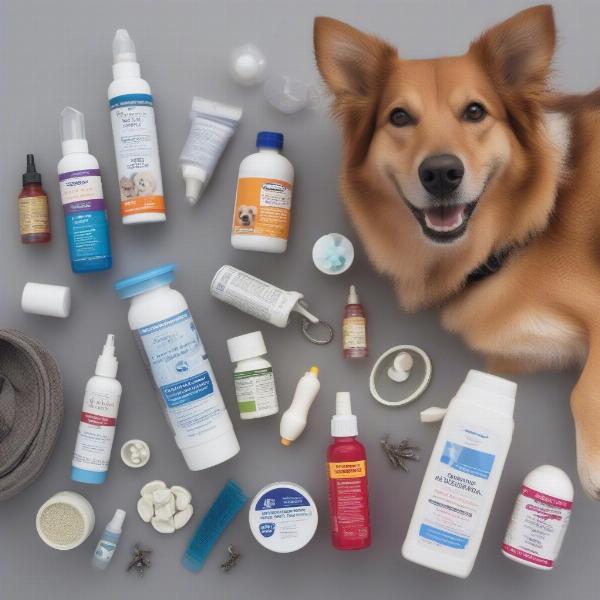Glycerin is a common ingredient in many commercial and homemade flea sprays for dogs. But is it truly effective, and more importantly, is it safe for our furry friends? This article delves into the role of glycerin in flea sprays, exploring its benefits, potential risks, and how it compares to other flea and tick control methods. We’ll examine the science behind its use, offer practical tips for choosing and using flea sprays containing glycerin, and discuss alternative solutions for managing fleas on your dog.
Understanding Glycerin’s Role in Flea Sprays
Glycerin, also known as glycerol, is a colorless, odorless, viscous liquid with a sweet taste. It’s a humectant, meaning it attracts and retains moisture. In flea sprays, glycerin serves several purposes. Primarily, it acts as a moisturizing agent, helping to prevent dryness and irritation of your dog’s skin often caused by other ingredients in the spray. Additionally, glycerin can contribute to the spray’s viscosity, making it adhere better to the fur and skin, potentially prolonging its effectiveness. Some proponents also believe glycerin can suffocate fleas, though scientific evidence for this claim is limited.
Many pet owners turn to flea sprays containing glycerin due to its perceived natural and gentle properties. However, it’s crucial to remember that “natural” doesn’t automatically equate to “safe” or “effective.” While glycerin itself is generally considered safe for dogs in appropriate concentrations, other ingredients in the spray might pose risks.
Is Glycerin Effective Against Fleas?
While glycerin contributes to the overall function of a flea spray, it’s not the primary active ingredient responsible for killing or repelling fleas. Most flea sprays rely on insecticides like pyrethrins, permethrins, or fipronil to eliminate fleas. Glycerin’s role is supplementary, improving the application and reducing potential skin irritation. Therefore, relying solely on a glycerin-based spray without proven insecticides is unlikely to effectively control a flea infestation.
Potential Risks and Precautions
Glycerin is generally considered safe for topical use on dogs. However, some dogs may experience allergic reactions, such as skin redness, itching, or hives. Always perform a patch test before applying a new flea spray to your entire dog. Apply a small amount to a small area of skin and observe for any adverse reactions within 24 hours.
Furthermore, the other ingredients in the flea spray are more likely to cause problems than the glycerin itself. Carefully read the product label and follow the instructions precisely. Avoid contact with your dog’s eyes and mouth. If your dog ingests a significant amount of flea spray, consult your veterinarian immediately.
Alternatives to Glycerin-Based Flea Sprays
Several effective alternatives to glycerin-based flea sprays are available, including:
- Flea and tick collars: These collars release insecticides that kill and repel fleas and ticks.
- Oral medications: These medications provide systemic flea and tick protection.
- Topical treatments: These spot-on treatments are applied directly to your dog’s skin and provide long-lasting protection.
- Flea shampoos and dips: These products kill fleas on contact but offer only temporary protection.
 Various flea and tick treatments for dogs
Various flea and tick treatments for dogs
“Choosing the right flea control method depends on your dog’s individual needs and lifestyle,” says Dr. Emily Carter, a veterinary dermatologist. “Consult your veterinarian to discuss the best options for your furry friend.”
Conclusion
Glycerin plays a supporting role in flea sprays for dogs, primarily as a moisturizer and viscosity enhancer. While generally safe, it’s not the primary flea-killing ingredient. Always choose a flea spray with a proven insecticide and follow the instructions carefully. If you have any concerns about using glycerin-based flea sprays, consult your veterinarian to explore the best flea and tick control strategy for your dog.
FAQ
- Is glycerin toxic to dogs? Glycerin is generally considered safe for dogs when used topically in appropriate concentrations.
- Can I make my own flea spray with glycerin? While possible, homemade flea sprays are often less effective than commercial products. Consult your veterinarian before using any homemade flea and tick treatments.
- How often should I use a flea spray on my dog? Follow the product label instructions for frequency of application.
- What should I do if my dog has an allergic reaction to a flea spray? Discontinue use immediately and contact your veterinarian.
- Can I use a flea spray containing glycerin on puppies? Consult your veterinarian before using any flea spray on puppies.
ILM Dog is your trusted source for comprehensive and practical information on dog care and well-being. We offer expert advice on everything from breed selection and health care to training and nutrition. Discover more valuable resources and connect with our community of passionate dog lovers. Contact us today for personalized guidance and support! Email: [email protected] Phone: +44 20-3965-8624. ILM Dog offers a wide array of services to help you navigate the rewarding journey of dog ownership. From breed selection to health and nutrition, our team is here to assist you every step of the way.